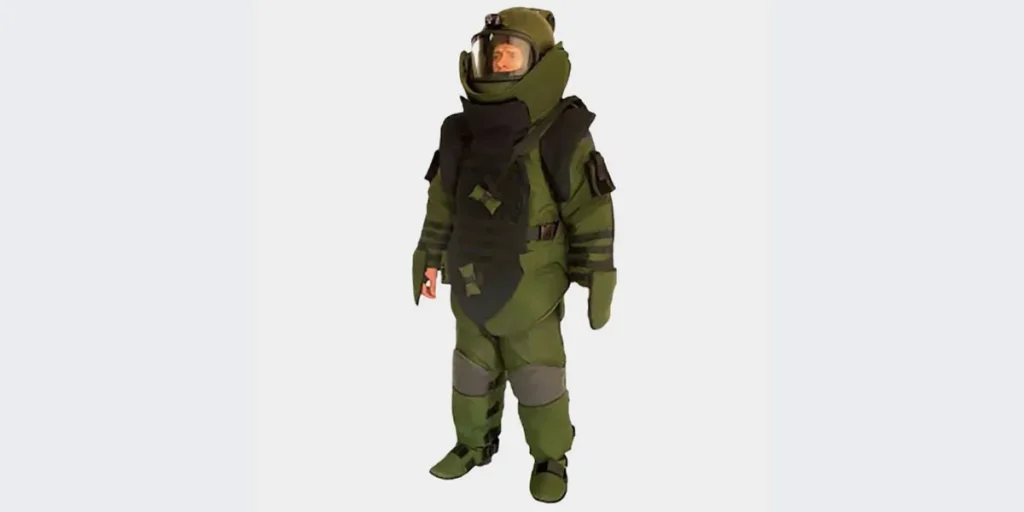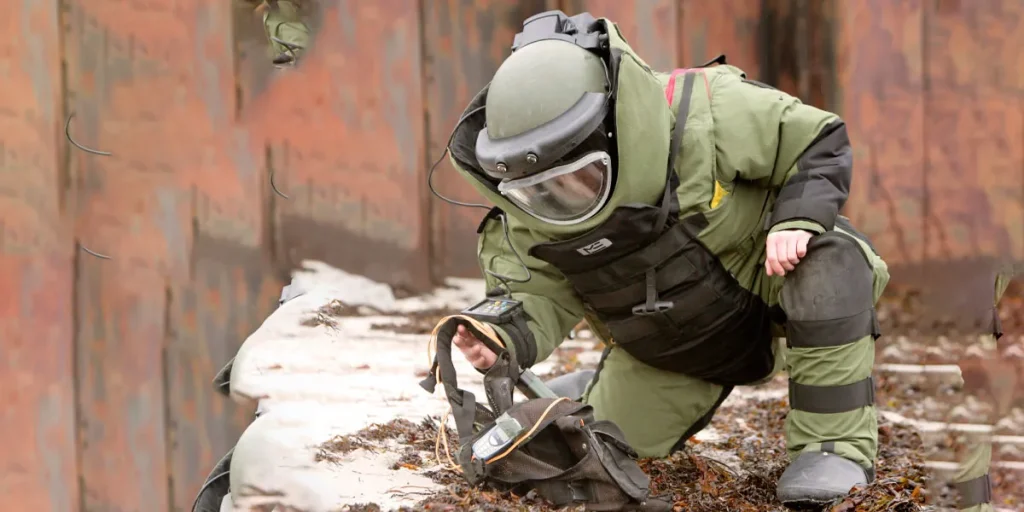A typical bomb suit weighs between 75 to 90 pounds (34 to 40.8 kilograms). Bomb suits vary in weight depending on the design and protection level.
Protecting explosive ordnance disposal (EOD) technicians, bomb suits are an essential part of their gear.
These specialized suits are designed to shield against the blast pressure, fragmentation, and thermal effects of an explosion.
EOD professionals must wear these heavy, yet critical suits to approach and dismantle or dispose of explosive devices safely.
While the weight of a bomb suit offers a significant level of protection, it also requires the wearer to have a high degree of physical fitness to maneuver effectively.
The balance between mobility and safety is crucial in the design of these suits, ensuring that technicians can perform their duties without compromising their protection.
As technology advances, the protection level and the ergonomic design of bomb suits continue to evolve, always with the primary goal of saving lives and minimizing injury during explosive device management scenarios.
The Purpose Of Bomb Suits

Bomb suits provide a critical layer of protection. They shield EOD technicians from blasts. Their purpose is to save lives. Bomb suits protect against shrapnel, heat, and overpressure from explosions.
Essential Protection For Eod Technicians
EOD professionals face extreme risks. They handle unexploded ordnance and improvised explosive devices. Bomb suits are their main defense.
They reduce injury risks during operations. With layers of advanced materials, these suits offer:
- Blast suppression: They manage the impact from explosions.
- Fragmentation resistance: High-strength fibers catch flying debris.
- Heat insulation: They keep extreme temperatures away from the body.
Design Criteria And Safety Standards
Bomb suits follow strict safety standards. They meet specifications detailing:
| Feature | Requirement |
|---|---|
| Material | Durable, multi-layered construction |
| Flexibility | Allow full range of movement |
| Weight Distribution | Balance to prevent fatigue |
| Certification | NIJ and other relevant standards |
The standards ensure max protection while allowing movement. Suit weight varies, but each conforms to these criteria. The goal: to offer a second skin for challenging EOD tasks.
Materials And Construction Of Bomb Suits

The materials and construction of bomb suits are critical. They determine not only the weight but also the level of protection.
Below, we delve into what makes these suits a formidable barrier against explosive threats. We explore the use of high-tech fabrics and tough composite layers.
Let’s unwrap this life-saving ensemble.
High-tech Fabrics And Tough Composite Layers
Bomb suits integrate state-of-the-art materials. These fabrics offer durability and resistance. They include aramids like Kevlar and Twaron.
These materials can stop shrapnel and reduce blast impact.
- Aramids: Heat-resistant and strong synthetic fibers.
- EOD suit linings: Absorb shock waves from blasts.
- Flame-resistant outer layers: Protect against fire and heat.
Balancing Mobility With Safety
Designers face a tough challenge with bomb suits. They must balance weight and mobility with safety. Too heavy, and the suit limits movement.
Too light, and it may not protect well enough. The aim is to find a perfect balance.
| Component | Function | Material |
|---|---|---|
| Helmets | Protects the head | Visors, Polycarbonate layers |
| Vests | Shields vital organs | Aramid fibers, Foam padding |
| Limbs | Covers arms and legs | Impact-absorbing materials |
Each piece of the suit serves a purpose. Helmets guard the head. Vests shield the heart and lungs. The arm and leg gear protect limbs. All pieces are vital for safety.
Analyzing Bomb Suit Weight
Welcome to our deep dive into the world of bomb suits. These critical pieces of equipment are vital for the safety of EOD (Explosive Ordnance Disposal) technicians.
Here, we will analyze just how much a bomb suit weighs and the various aspects that contribute to its mass.
Typical Weight Ranges And Variations
Bomb suits carry significant bulk due to their life-saving components. They vary in weight depending on design and materials.
- Light-duty suits: These weigh between 25 to 35 pounds and offer mobility.
- Mid-range suits: Weighing between 45 to 60 pounds, they balance protection with agility.
- Heavy-duty suits: Often exceed 75 pounds and provide the highest level of protection.
Just as soldiers carry different weapons, bomb suits adjust for different threats.
Factors Influencing The Heaviness Of The Suit
Multiple factors add to the suit’s heaviness. Each aspect plays a role in overall weight.
- Material: Kevlar and other high-tech fibers are common. They are light but add up.
- Protection level: Higher threat levels require more layers. More layers mean more weight.
- Accessories: Cooling systems, helmets, visors, all add pounds.
- Size: Larger suits for taller wearers naturally weigh more.
Despite heavy suits, technicians train to move effectively and stay safe. Next, we examine specific suits and their unique weight profiles.
Physical Impact On Eod Operators
The weight of a bomb suit significantly impacts EOD operators in their crucial safety roles.
These protective gears are not just heavy armors; they envelop these brave souls, safeguarding them amidst extreme danger. Yet, this often comes with a physical toll.
Challenges Of Prolonged Wear
Wearing a bomb suit for extended periods is a strenuous affair. EOD operators face multiple challenges:
- Intensive heat accumulation
- Limited mobility and agility
- Increased exertion leading to fatigue
The suit, often weighing between 75 to 100 pounds, is akin to carrying an extra person with every step.
This strain can compromise focus and dexterity, crucial in bomb defusion tasks.
Training For Endurance And Suit Management
Comprehensive training programs are pivotal for EOD professionals. These programs focus on:
- Improving cardiovascular stamina
- Building strength for load-bearing
- Developing suit-wearing techniques
Regular simulations and physical drills ensure operators can endure the weight and maneuver efficiently. This preparation is vital for successful, safe operations.
Advancements And Future Design
Understanding the weight and features of a bomb suit is crucial for safety and mobility.
The latest advancements shape the future of bomb suit design, emphasising lighter, stronger materials and cutting-edge technology.
Let’s dive into the improvements aimed at making these suits safer and more comfortable for the brave individuals using them.
Lighter Materials And Enhanced Protection
Scientists and engineers are continuously working on new materials that offer superior protection without the traditional heft.
These innovative fabrics aim to reduce suit weight significantly, enhancing user endurance and agility.
- High-performance polymers – offer robust blast resistance at lower weights
- Advanced composites – provide excellent protection while shedding pounds
- Layered textiles – combine to prevent shrapnel penetration, at less weight
Exoskeleton Integration And Weight Distribution
The integration of exoskeleton technology is a game-changer for bomb suits.
This addition supports the wearer’s body, improving mobility and strength, crucial during prolonged usage.
Weight distribution technologies evenly spread the load, preventing excessive fatigue.
| Exoskeleton Feature | Benefit |
|---|---|
| Powered Joints | Assists movement and reduces strain |
| Load Carriage System | Efficient weight distribution |
| Modular Design | Customizable support where needed |
Real-world Deployment Of Bomb Suits
The real-world deployment of bomb suits is a critical factor in the safety and efficiency of explosive ordnance disposal (EOD) teams.
With the bomb suit’s weight being a significant concern, its performance during active operations reveals much about its practicality and areas for potential improvement.
Case Studies And Operational Experiences
Understanding how bomb suits function in the field comes from analyzing case studies and soldiers’ experiences.
Bomb suits are subjected to extreme conditions, and their weight can impact mission outcome.
- Diffusing live explosives puts EOD technicians at high risk.
- Suits must offer optimal protection and mobility.
- Each operation tests the suit’s limits, from urban landscapes to rugged terrain.
| Operation | Location | Suit Weight Impact |
|---|---|---|
| IED Disposal | Urban Street | Maneuverability Crucial |
| Unexploded Ordnance | Remote Area | Endurance Challenged |
These examples shed light on real-world suit performance under diverse circumstances.
Future Implications For Eod Suit Design
Innovations are shaping the future of EOD suits. Integrating case study insights leads to lighter, stronger, and more flexible designs.
- Materials technology advances allow weight reduction without compromising protection.
- Sensors and robotics improve operational capability, possibly reducing time in suits.
- Ergonomics play a pivotal role in enhancing comfort and mobility.
These developments aim to equip EOD technicians with suits that maximize performance and safety.
FAQs About the Weight of a Bomb Suit
What Is The Average Weight Of A Bomb Suit?
The average bomb suit weighs between 75 to 85 pounds (34 to 38. 5 kilograms). This includes the helmet, body armor, and protective gear.
Can Bomb Suits Withstand Explosions?
Bomb suits are designed to withstand explosions from small explosive devices.
They protect wearers from blast pressure, shrapnel, and heat, but cannot guarantee full protection against direct or large blasts.
What Components Make Up A Bomb Suit?
A bomb suit typically consists of a helmet with a face shield, a torso protective suit with arm and leg coverings, and robust boots.
It often includes a cooling system for dealing with heat stress.
How Do Bomb Suits Provide Protection?
Bomb suits protect through layers of Kevlar, bomb blast-absorbing foam, and other materials.
They shield against shrapnel, heat, and overpressure, but mobility is sacrificed for protection.
Conclusion
Bomb suits are vital for explosive ordnance disposal experts, balancing protection with mobility.
Typically, these suits weigh between 50 to 80 pounds, though advanced materials continue to evolve.
Safety is the priority, but every pound matters in high-stress scenarios. Users must weigh these factors when choosing their crucial protective gear.
Understanding this balance is key for those braving dangerous disposal tasks.
Resources:
https://nij.ojp.gov/library/publications/bomb-suit-standard
https://ec.usembassy.gov/the-u-s-government-donated-five-protective-bomb-suits-to-the-national-police-valued-at-245000/
